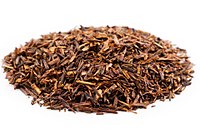
Photo from wikipedia
Abstract We investigated the different functional strategies of N nutrition of cultivated and wild varieties of the legume Aspalathus linearis (N.L.Burm.) R.Dahlgren during wet and dry seasons in the Cape… Click to show full abstract
Abstract We investigated the different functional strategies of N nutrition of cultivated and wild varieties of the legume Aspalathus linearis (N.L.Burm.) R.Dahlgren during wet and dry seasons in the Cape Floristic Region. The study addressed differences in soil and plant N cycling in cultivated and wild varieties of A. linearis. The seasonal variation in biological N2 fixation (BNF), soil microbial activity, as well as N cycling strategies, were investigated in wild and cultivated varieties of the legume of A. linearis. Fresh leaf samples, leaf litter samples and soil samples were collected during dry and wet seasons for both cultivated and wild-growing A. linearis. Plant samples were analysed for δ15N and total N content. Percentage N resorption was calculated. Soil N, C, P, urease and β-glucosidase were determined directly at the rhizosphere and in bulk soil. During the wet seasons, wild plants had an increased reliance on biological N2 fixation (BNF). This was attributed to an increase in soil microbial activity, which can lead to competition between roots and soil microbes for mineralized soil N. No trade-off between N sources in plants was found and plants tend not to rely more on BNF when microbial activity is low. Wild and cultivated A. linearis plants use different N cycling strategies, where wild plants are more reliant on biological N2 fixation (BNF) whilst cultivated plants tend to retain N.
Journal Title: Applied Soil Ecology
Year Published: 2018
Link to full text (if available)
Share on Social Media: Sign Up to like & get
recommendations!